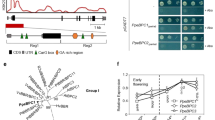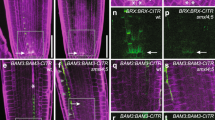Abstract
The lipid-derived hormone jasmonate (JA) regulates plant immunity and adaptive growth by triggering a genome-wide transcriptional programme. In Arabidopsis thaliana, JA-triggered transcriptional programming is largely orchestrated by the master transcription factor MYC2. The function of MYC2 is dependent on its physical interaction with the MED25 subunit of the Mediator transcriptional co-activator complex. Here we report the identification of JA enhancers (JAEs) through profiling the occupancy pattern of MYC2 and MED25. JA regulates the dynamic chromatin looping between JAEs and their promoters in a MED25-dependent manner, while MYC2 auto-regulates itself through JAEs. Interestingly, the JAE of the MYC2 locus (named ME2) positively regulates MYC2 expression during short-term JA responses but negatively regulates it during constant JA responses. We demonstrate that new gene editing tools open up new avenues to elucidate the in vivo function of enhancers. Our work provides a paradigm for functional study of plant enhancers in the regulation of specific physiological processes.
This is a preview of subscription content, access via your institution
Access options
Access Nature and 54 other Nature Portfolio journals
Get Nature+, our best-value online-access subscription
$29.99 / 30 days
cancel any time
Subscribe to this journal
Receive 12 digital issues and online access to articles
$119.00 per year
only $9.92 per issue
Buy this article
- Purchase on Springer Link
- Instant access to full article PDF
Prices may be subject to local taxes which are calculated during checkout






Similar content being viewed by others
Data availability
All sequencing data have been deposited under accession number CRA001078 (Bioproject Accession: PRJCA001012, Experiment Accessions: CRR032459, CRR032460, CRR032461, CRR032462, CRR032463) and are available from the website of the Genome Sequence Archive (GSA) (http://bigd.big.ac.cn/bioproject/browse/PRJCA001012) of the Beijing Institute of Genomics Data Center.
References
Browse, J. Jasmonate passes muster: a receptor and targets for the defense hormone. Annu. Rev. Plant Biol. 60, 183–205 (2009).
Wasternack, C. & Hause, B. Jasmonates: biosynthesis, perception, signal transduction and action in plant stress response, growth and development. An update to the 2007 review in Annals of Botany. Ann. Bot. 111, 1021–1058 (2013).
Howe, G. A., Major, I. T. & Koo, A. J. Modularity in jasmonate signaling for multistress resilience. Annu. Rev. Plant Biol. 69, 387–415 (2018).
Boter, M., Ruiz-Rivero, O., Abdeen, A. & Prat, S. Conserved MYC transcription factors play a key role in jasmonate signaling both in tomato and Arabidopsis. Genes Dev. 18, 1577–1591 (2004).
Lorenzo, O., Chico, J. M., Sanchez-Serrano, J. J. & Solano, R. JASMONATE-INSENSITIVE1 encodes a MYC transcription factor essential to discriminate between different jasmonate-regulated defense responses in Arabidopsis. Plant Cell 16, 1938–1950 (2004).
Kazan, K. & Manners, J. M. MYC2: the master in action. Mol. Plant 6, 686–703 (2013).
Dombrecht, B. et al. MYC2 differentially modulates diverse jasmonate-dependent functions in Arabidopsis. Plant Cell 19, 2225–2245 (2007).
Du, M. et al. MYC2 orchestrates a hierarchical transcriptional cascade that regulates jasmonate-mediated plant immunity in tomato. Plant Cell 29, 1883–1906 (2017).
Pauwels, L. et al. NINJA connects the co-repressor TOPLESS to jasmonate signalling. Nature 464, 788–791 (2010).
Thines, B. et al. JAZ repressor proteins are targets of the SCFCOI1 complex during jasmonate signalling. Nature 448, 661–665 (2007).
Xu, L. et al. The SCFCOI1 ubiquitin-ligase complexes are required for jasmonate response in Arabidopsis. Plant Cell 14, 1919–1935 (2002).
Sheard, L. B. et al. Jasmonate perception by inositol-phosphate-potentiated COI1-JAZ co-receptor. Nature 468, 400–405 (2010).
Cevik, V. et al. MEDIATOR25 acts as an integrative hub for the regulation of jasmonate-responsive gene expression in Arabidopsis. Plant Physiol. 160, 541–555 (2012).
Chen, R. et al. The Arabidopsis mediator subunit MED25 differentially regulates jasmonate and abscisic acid signaling through interacting with the MYC2 and ABI5 transcription factors. Plant Cell 24, 2898–2916 (2012).
An, C. et al. Mediator subunit MED25 links the jasmonate receptor to transcriptionally active chromatin. Proc. Natl Acad. Sci. USA 114, E8930–E8939 (2017).
Shlyueva, D., Stampfel, G. & Stark, A. Transcriptional enhancers: from properties to genome-wide predictions. Nat. Rev. Genet. 15, 272–286 (2014).
Weber, B., Zicola, J., Oka, R. & Stam, M. Plant enhancers: a call for discovery. Trends Plant Sci. 21, 974–987 (2016).
Zabidi, M. A. & Stark, A. Regulatory enhancer-core-promoter communication via transcription factors and cofactors. Trends Genet. 32, 801–814 (2016).
Levine, M., Cattoglio, C. & Tjian, R. Looping back to leap forward: transcription enters a new era. Cell 157, 13–25 (2014).
Allen, B. L. & Taatjes, D. J. The Mediator complex: a central integrator of transcription. Nat. Rev. Mol. Cell Biol. 16, 155–166 (2015).
Soutourina, J. Transcription regulation by the Mediator complex. Nat. Rev. Mol. Cell Biol. 19, 262–274 (2018).
Zhu, B., Zhang, W., Zhang, T., Liu, B. & Jiang, J. Genome-wide prediction and validation of intergenic enhancers in Arabidopsis using open chromatin signatures. Plant Cell 27, 2415–2426 (2015).
Marand, A. P., Zhang, T., Zhu, B. & Jiang, J. Towards genome-wide prediction and characterization of enhancers in plants. Biochim. Biophys. Acta 1860, 131–139 (2017).
Li, Q. H., Brown, J. B., Huang, H. Y. & Bickel, P. J. Measuring reproducibility of high-throughput experiments. Ann. Appl. Stat. 5, 1752–1779 (2011).
Landt, S. G. et al. ChIP-seq guidelines and practices of the ENCODE and modENCODE consortia. Genome Res. 22, 1813–1831 (2012).
Zhang, Y. et al. Model-based analysis of ChIP-seq (MACS). Genome Biol. 9, R137 (2008).
Heinz, S. et al. Simple combinations of lineage-determining transcription factors prime cis-regulatory elements required for macrophage and B cell identities. Mol. Cell 38, 576–589 (2010).
Hagege, H. et al. Quantitative analysis of chromosome conformation capture assays (3C-qPCR). Nat. Protoc. 2, 1722–1733 (2007).
Staswick, P. E., Su, W. & Howell, S. H. Methyl jasmonate inhibition of root growth and induction of a leaf protein are decreased in an Arabidopsis thaliana mutant. Proc. Natl Acad. Sci. USA 89, 6837–6840 (1992).
Bjorklund, S. & Gustafsson, C. M. The yeast Mediator complex and its regulation. Trends Biochem. Sci. 30, 240–244 (2005).
Kornberg, R. D. Mediator and the mechanism of transcriptional activation. Trends Biochem. Sci. 30, 235–239 (2005).
Kelleher, R. J. 3rd, Flanagan, P. M. & Kornberg, R. D. A novel mediator between activator proteins and the RNA polymerase II transcription apparatus. Cell 61, 1209–1215 (1990).
Fondell, J. D., Ge, H. & Roeder, R. G. Ligand induction of a transcriptionally active thyroid hormone receptor coactivator complex. Proc. Natl Acad. Sci. USA 93, 8329–8333 (1996).
Carlsten, J. O., Zhu, X. & Gustafsson, C. M. The multitalented Mediator complex. Trends Biochem. Sci. 38, 531–537 (2013).
Backstrom, S., Elfving, N., Nilsson, R., Wingsle, G. & Bjorklund, S. Purification of a plant mediator from Arabidopsis thaliana identifies PFT1 as the Med25 subunit. Mol. Cell 26, 717–729 (2007).
Kidd, B. N., Cahill, D. M., Manners, J. M., Schenk, P. M. & Kazan, K. Diverse roles of the Mediator complex in plants. Semin. Cell Dev. Biol. 22, 741–748 (2011).
Whyte, W. A. et al. Master transcription factors and mediator establish super-enhancers at key cell identity genes. Cell 153, 307–319 (2013).
Zhang, X. et al. Mediator subunit MED31 is required for radial patterning of Arabidopsis roots. Proc. Natl Acad. Sci. USA 115, E5624–E5633 (2018).
Yan, L. et al. High-efficiency genome editing in Arabidopsis using YAO promoter-driven CRISPR-Cas9 system. Mol. Plant 8, 1820–1823 (2015).
Zhu, J. Y., Sun, Y. & Wang, Z. Y. Genome-wide identification of transcription factor-binding sites in plants using chromatin immunoprecipitation followed by microarray (ChIP-chip) or sequencing (ChIP-seq). Methods Mol. Biol. 876, 173–188 (2012).
Li, H. & Durbin, R. Fast and accurate short read alignment with Burrows-Wheeler transform. Bioinformatics 25, 1754–1760 (2009).
Li, H. et al. The Sequence Alignment/Map format and SAMtools. Bioinformatics 25, 2078–2079 (2009).
Ramirez, F., Dundar, F., Diehl, S., Gruning, B. A. & Manke, T. deepTools: a flexible platform for exploring deep-sequencing data. Nucleic Acids Res. 42, W187–W191 (2014).
Quinlan, A. R. & Hall, I. M. BEDTools: a flexible suite of utilities for comparing genomic features. Bioinformatics 26, 841–842 (2010).
Bailey, T. L. DREME: motif discovery in transcription factor ChIP-seq data. Bioinformatics 27, 1653–1659 (2011).
Bailey, T. L. & Machanick, P. Inferring direct DNA binding from ChIP-seq. Nucleic Acids Res. 40, e128 (2012).
Bailey, T. L. & Elkan, C. Fitting a mixture model by expectation maximization to discover motifs in biopolymers. Proc. Int. Conf. Intell. Syst. Mol. Biol. 2, 28–36 (1994).
Louwers, M., Splinter, E., van Driel, R., de Laat, W. & Stam, M. Studying physical chromatin interactions in plants using Chromosome Conformation Capture (3C). Nat. Protoc. 4, 1216–1229 (2009).
Acknowledgements
We thank Q. Xie for providing the Yao promoter-driven CRISPR–Cas9 system. This work was supported by the National Key Research and Development Programme of China (No. 2016YFD0100600), the Strategic Priority Research Programme of the Chinese Academy of Sciences (No. XDB11030200), the National Natural Science Foundation of China (No. 31730010), and the Tai-Shan Scholar Programme from Shandong Province.
Author information
Authors and Affiliations
Contributions
J.Z. and C.L. designed the project. H.W., S.L., Y.L., R.Z., W.S. and Q.C. performed the experiments. Y.X., Y.W. and X.-J.W. performed the bioinformatics analysis. C.L. and J.Z. wrote the manuscript. All authors read and approved the final manuscript.
Corresponding authors
Ethics declarations
Competing interests
The authors declare no competing interests.
Additional information
Journal Peer Review Information: Nature Plants thanks Kemal Kezan, Roberto Solano and other anonymous reviewers for their contribution to the peer review of this work.
Publisher’s note: Springer Nature remains neutral with regard to jurisdictional claims in published maps and institutional affiliations.
Supplementary information
Supplementary Information
Supplementary Figs. 1–6, Supplementary Tables 1 and 2
Supplementary datasets 1–6
Supplementary dataset 1, Occupancy profile of MYC2. Supplementary dataset 2, Occupancy profile of MED25. Supplementary dataset 3, MMOSs (co-occupancy sites of MYC2 and MED25). Supplementary dataset 4, MMOSs with G-box. Supplementary dataset 5, Putative JAEs. Supplementary dataset 6, Representatice JAEs.
Rights and permissions
About this article
Cite this article
Wang, H., Li, S., Li, Y. et al. MED25 connects enhancer–promoter looping and MYC2-dependent activation of jasmonate signalling. Nat. Plants 5, 616–625 (2019). https://doi.org/10.1038/s41477-019-0441-9
Received:
Accepted:
Published:
Issue Date:
DOI: https://doi.org/10.1038/s41477-019-0441-9
This article is cited by
-
A distal enhancer guides the negative selection of toxic glycoalkaloids during tomato domestication
Nature Communications (2024)
-
Petal abscission is promoted by jasmonic acid-induced autophagy at Arabidopsis petal bases
Nature Communications (2024)
-
The Mediator kinase module enhances polymerase activity to regulate transcriptional memory after heat stress in Arabidopsis
The EMBO Journal (2024)
-
Metabolomic and genome-wide association studies drive genetic dissection and gene mining in tea plant
Horticulture Advances (2024)
-
Autophagy promotes jasmonate-mediated defense against nematodes
Nature Communications (2023)



